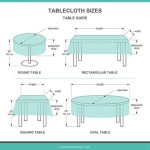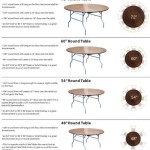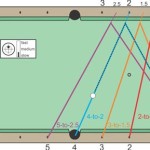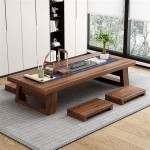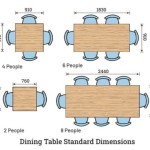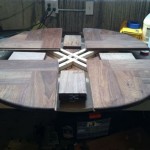Standard Bar Size Pool Table Dimensions: A Comprehensive Guide
Pool tables, commonly found in bars, recreational centers, and homes, provide a source of entertainment and a platform for friendly competition. Understanding the dimensions of a standard bar-size pool table is crucial for both players and those planning to purchase or accommodate one. These dimensions influence gameplay, room space requirements, and overall aesthetic appeal. This article provides a detailed overview of standard bar-size pool table dimensions, exploring the various components and considerations necessary for informed decision-making.
Defining "Bar Size" and its Significance
The term "bar size" in reference to pool tables typically refers to a 7-foot table. This designation is primarily based on the playing surface length between the two sets of rails. While variations exist, a 7-foot table is the most common size encountered in commercial establishments such as bars and pubs. This size strikes a balance between providing a sizable playing area and fitting comfortably within typical barroom space constraints.
The significance of adhering to standard dimensions is multi-faceted. It ensures a consistent playing experience across different locations, allowing players to adapt quickly regardless of the specific venue. Furthermore, standardized dimensions facilitate the production and availability of accessories like pool cues, balls, and table brushes specifically designed for that size table. Finally, standardized sizes simplify the process of rule enforcement, particularly in competitive leagues where uniform table dimensions guarantee a fair playing field.
Detailed Dimensions of a Standard Bar-Size Pool Table
Understanding the specific measurements of the various components of a 7-foot pool table is essential for assessing space requirements and ensuring proper gameplay. These dimensions encompass the overall table size, the playing surface, the rail height, and the pocket openings.
Overall Table Dimensions: The overall dimensions of a standard 7-foot pool table are approximately 87 inches long and 50 inches wide. This measurement includes the rails and the cabinet surrounding the playing surface. Note that slight variations can occur depending on the specific manufacturer and design.
Playing Surface Dimensions: The playing surface, also known as the slate bed, is the area where the pool balls roll. For a 7-foot table, the playing surface measures approximately 76 inches long and 38 inches wide. This translates to a ratio of 2:1, which is a standard proportion for pool tables of all sizes. Adherence to this ratio is crucial for maintaining the integrity of the game and preventing inaccurate shots.
Rail Height: The rails, also known as cushions, are the padded borders that surround the playing surface. The height of the rails from the playing surface is typically around 2.25 inches. This height is carefully calibrated to ensure proper ball rebound during gameplay. Variations in rail height can impact ball behavior and make it difficult to predict shot trajectories.
Pocket Openings: The pocket openings are the holes located at the corners and along the sides of the table. Their size determines the difficulty of sinking balls. The corner pockets are generally wider than the side pockets. While no single governing body dictates precise pocket dimensions for recreational tables, standard bar-size tables typically have corner pocket openings that range from 4.5 to 5 inches, and side pocket openings that range from 5 to 5.5 inches. These dimensions must allow for a regulation-size pool ball (2.25 inches in diameter) to enter consistently, while still presenting a sufficient challenge for players.
Table Height: The standard height of a pool table, measured from the floor to the top of the rail, is typically between 29.25 and 31 inches. This height is designed to comfortably accommodate players of average stature, allowing them to reach over the table and execute shots with proper posture. Deviations from this standard height can lead to discomfort and impact shot accuracy.
Slate Thickness: The slate bed is the foundation of the pool table and is responsible for providing a perfectly level and smooth playing surface. The thickness of the slate typically ranges from ¾ inch to 1 inch for a 7-foot table. Thicker slate provides greater stability and resistance to warping, resulting in a more consistent and predictable playing experience. Although thinner slate options may exist, they are generally less desirable due to their increased susceptibility to damage and unevenness.
Factors Influencing Pool Table Size Selection
Selecting the appropriate pool table size involves considering several factors, including available space, skill level, and budget. While a 7-foot "bar size" table is common, it may not be the optimal choice for every situation. Weighing these factors carefully is crucial for making an informed decision that aligns with specific needs and preferences.
Available Space: The single most important factor in determining the appropriate pool table size is the amount of available space. A general rule of thumb is to allow at least 5 feet of unobstructed space around each side of the table to accommodate players' cue movements. This means that for a 7-foot table with overall dimensions of approximately 87 inches (7.25 feet) by 50 inches (4.17 feet), a room measuring at least 17.25 feet long and 14.17 feet wide is recommended.
Insufficient space can severely hinder gameplay, restricting players' ability to execute shots and leading to frustration. In situations where space is limited, opting for a smaller table size, such as a 6-foot or even a 5-foot model, may be a more practical solution. Alternatively, using shorter cues can alleviate some space constraints, but this may compromise shot accuracy and power.
Skill Level: While table size does not directly dictate skill level, it can influence the learning curve and overall playing experience. Smaller tables, such as 7-foot models, require less precision and strategic planning due to the shorter distances between balls. This makes them suitable for casual players and beginners who are still developing their skills. Larger tables, such as 8-foot or 9-foot models, demand greater accuracy and positional play, making them more challenging and rewarding for experienced players.
Budget: Pool table prices vary considerably depending on size, materials, and construction quality. Generally, larger tables are more expensive than smaller tables due to the increased material requirements and complexity of manufacturing. In addition to the table itself, it is essential to factor in the cost of accessories, such as cues, balls, a rack, and a table brush. While a 7-foot table typically represents a mid-range price point, budget constraints may necessitate opting for a smaller table or choosing a model with less expensive materials.
Purpose and Intended Use: The intended use of the pool table should also influence the size selection. If the primary purpose is casual entertainment and social gatherings, a 7-foot table may be perfectly adequate. However, if the table is intended for serious practice or competitive play, a larger table, such as an 8-foot or 9-foot model, may be more appropriate. Furthermore, the aesthetic appeal of the table and how it complements the surrounding décor should be considered. The size and style of the table should be harmonious with the overall design of the room.
Alternatives to Standard Bar Size
While the 7-foot pool table holds the designation of "bar size," alternative sizes are available and may be more suitable depending on the specific context. Understanding these alternatives allows for a more informed purchasing decision and ensures that the chosen table best fits the available space and intended use. The most common alternatives are 6-foot, 8-foot, and 9-foot tables.
6-Foot Pool Tables: Six-foot pool tables are significantly smaller than 7-foot tables and are often marketed towards children or individuals with very limited space. While they offer a reduced playing surface, they can still provide a satisfying gaming experience for casual players. The smaller size makes them easier to fit into apartments, game rooms, or other compact spaces. However, the reduced playing area also limits the complexity of shots and the potential for strategic play.
8-Foot Pool Tables: Eight-foot pool tables represent a step up in size from 7-foot tables and are often considered the standard size for home use by more serious players. They offer a larger playing surface than 7-foot tables, allowing for more challenging shots and strategic maneuvering. Eight-foot tables require more space than 7-foot tables but are still manageable in many homes. They strike a good balance between size, playability, and space requirements, making them a popular choice for intermediate and advanced players.
9-Foot Pool Tables: Nine-foot pool tables are the largest standard size and are typically used in professional tournaments and competitive leagues. They offer the most expansive playing surface, demanding exceptional precision, strategic planning, and cue ball control. Nine-foot tables require a significant amount of space and are best suited for dedicated game rooms or professional billiard halls. They are generally reserved for experienced players who are committed to honing their skills and competing at a high level.
Beyond these standard sizes, custom-built pool tables can be manufactured to virtually any dimensions. However, custom tables are typically more expensive than standard sizes and may require specialized expertise for installation and maintenance.

The Official Size Of A Pool Table Canadian Home Leisure

What Is The Standard Size Of A Pool Table Measurement Guide Room

Pool Table Room Size Guide Chart Birkbeck Billiards

Pool Table Room Size Calculator

Room Size Specifications Olhausen Billiards

Room Size Pooltables Com

Room Size Specifications Olhausen Billiards

How To Measure A Pool Table 4 Dimensions

Pool Table Room Size Guide Chart Birkbeck Billiards

Pool Table Sizing Dimensions Room Size
Related Posts

